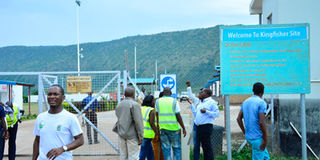Development of Kingfisher awaits pipeline decision

Marked out. The Kingfisher oil field in Hoima District which is under Cnooc. Photo by Eric Dominic Bukenya
What you need to know:
- The current stock tank of oil in place from the roughly 40 per cent area of the Albertine Graben in South Western Uganda explored so far, is 6.5 billion, with 1.7 billion recoverable, and about 500 billion cubic feet of gas resources.
Kampala. The Permanent Secretary in the Ministry of Energy, Mr Robert Kasande, yesterday said the announcement of Final Investment Decision (FID) for the Kingfisher and Tilenga oil fields is dependent on the FID of the proposed East African Crude Oil Export Pipeline.
FID is an agreement on capital investments on a long term project, that is when money for the project is availed and execution starts.
FID is expected to pave way for the Engineering, Procurement and Construction (EPC) phase and subsequently commencement of commercial of oil production.
“We would not want to develop an oil field without the attendant facilities which means it will lie there idle. So we have synchronised the Kingfisher FID to that of the pipeline and Tilenga so that we move at once,” Mr Kasande told journalists at the ministry offices in Kampala.
Kingfisher is operated by China’s Cnooc while Tilenga is under French Total E&P.
Energy minister Irene Muloni said government and Cnooc were looking at announcing FID for Kingfisher before the end of this month.
Government and oil companies are currently targeting early October to announce FID for development of Kingfisher, Tilenga and the oil pipeline but regardless of when it is eventually taken, Uganda’s first commercial oil is three years from FID, that is 2023.
Each time the FID date slips, so does the production start date.
Cnooc operates Exploration Area 3 (Kingfisher) in south of Lake Albert, and the southern fields—Waraga, Mputa and Nzizi—of Exploration Area 2, initially operated by Anglo-Irish Tullow before it sold them off.
Mr Kasande also said technical Front End Engineering Designs, environmental studies for Tilenga oil fields at the northern end of Lake Albert in Nwoya and Buliisa districts, was approved last month, adding that “integration of comments” and review of the company’s Environment Impact Assessment report is ongoing.
Acquisition of 700 acres of land in Buliisa for Tilenga’s attendant facilities faced hindrances after six project affected persons rejected the Shs3m compensation offered per acre and have insisted on being paid Shs21m.
Development of the Tilenga oil fields is estimated to cost about Shs14 trillion ($4b).
Discussions on development of the Shs13 trillion pipeline by Uganda, the three oil companies—Total E&P, Tullow and Cnooc, and Tanzania are ongoing.
In a related development, Mr Kasande said ongoing surveys for hydrocarbons (oil and gas) around the country have returned positive results in the Kadam-Moroto basin in northeastern Uganda, adding that they hope to licence the area.
Capacity
The current stock tank of oil in place from the roughly 40 per cent area of the Albertine Graben in South Western Uganda explored so far, is 6.5 billion, with 1.7 billion recoverable, and about 500 billion cubic feet of gas resources.




